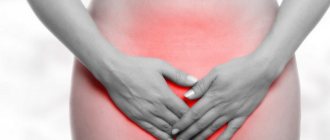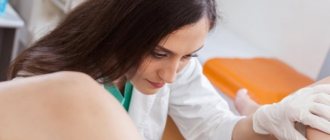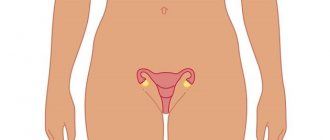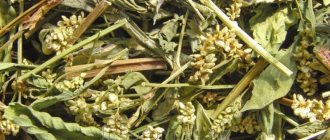The ability to reproduce, theoretically, should not create complications for the mother’s body - just like menstrual periods, which are considered a normal condition. In practice, in the first days of menstruation, women often feel anything but natural, and the pregnancy can fail or leave irreparable complications “as a souvenir.”
Thrush after childbirth is also more common than is commonly thought. In every 3rd woman it is temporary, occurring at a certain stage of pregnancy or lactation, and in every 7th it requires treatment for more than 2 weeks.
How do fungi enter the body?
Candida in most cases is part of the normal vaginal microflora. Fungi thrive in an acidic environment. Normally, the flora consists mainly of lactic bacteria (up to 95% of all microorganisms) and a small number of opportunistic pathogens. A small amount of gardnerella, mycoplasma, yeast-like fungi and other microbes are always present in the body, but their number is so small that it is not detected in a gynecological smear.
With a decrease in resistance, that is, the body's resistance, the number of lactobacilli decreases. An inflammatory process occurs, which is called vaginitis, or colpitis. Colpitis is dangerous because the inflammatory process of the external genital organs can spread to other organs involved in reproduction and lead to cervical erosion and endometritis. In some cases, the consequence of colpitis is infertility.
Symptoms
There are few main symptoms by which this disease can be identified, but they are all characteristic. Among the most common:
- White coating on the genitals.
- Unbearably strong burning and itching sensation.
- Painful going to the toilet.
- The discharge is white and cheesy.
If a woman in labor has previously noticed similar manifestations, she should immediately contact a gynecologist. A specialist will be able to prescribe the necessary therapy and eliminate the problem. Otherwise, there is a possibility of not only delaying the recovery process, but also infecting the baby. Fungi can spread too quickly and infect the baby through breast milk.
Why does the inflammatory process occur?
Colpitis may appear due to vaginal candidiasis. The inflammatory process is complicated if a woman, in addition to thrush, has human papillomavirus or hormonal disorders, cystic formations or prolapse of the vaginal walls (prolapse).
- During pregnancy, inhibition of immune processes occurs . This is called suppression of the immune response. This process is necessary for the normal course of pregnancy, because the fetus is half foreign to the mother’s body. To prevent rejection, the immune system is suppressed. And against the background of suppressed immunity, pathogenic microflora is activated.
- During pregnancy, there is an increase in glycogen levels . The presence of this polysaccharide creates favorable conditions for the proliferation of Candida fungi.
- Taking broad-spectrum leads to changes in flora and provokes the growth of Candida.
- After conception occurs, barrier contraception is used by a minimum of couples. And completely in vain, because transmission of fungi can occur through unprotected sexual contact.
- Thrush before childbirth may appear due to microtrauma of the vagina . In wounds, infection develops faster.
- Pregnant women may experience allergic reactions . Allergens can accumulate in the body, as a result of which thrush may appear in the last trimester.
- Patients with diabetes mellitus .
- Psycho-emotional reasons can also become a triggering factor for the disease. Almost every pregnant girl experiences stress when carrying a child.
Stress increases just before childbirth. Even if a woman has been calm throughout her pregnancy, waiting for the big day undermines the nervous system.
For wound healing
Of course, it is very good when childbirth takes place without any damage. But in most cases, especially if a woman gives birth for the first time, cracks or even ruptures cannot be avoided. Therefore, it is very important that all wounds heal well so that they do not become infected. Scarring and decreased libido may also result. In rare cases, there may even be urinary incontinence. If we are talking about tears and wounds, then we must also not forget that they require special care and treatment. For this you can use a light solution of potassium permanganate or hydrogen peroxide. And today, most doctors are confident. that there is no better remedy than vaginal suppositories. They promote rapid healing of internal wounds and have a softening effect on vaginal tissue. And in general, thanks to them, a woman recovers much faster. Another good difference is that these suppositories can be inserted deep into the body at night and they will help restore organs while the woman is resting. Your doctor will tell you which suppositories are best to choose.
Treatment before childbirth
Treatment of thrush before childbirth is reduced to the use of local antifungal drugs. Systemic drugs are not prescribed. This means that prescribing tablets for oral administration by gynecologists is not practiced.
- Most doctors advocate inserting Pimafucin suppositories.
- Terzhinan may also be prescribed.
- During pregnancy and lactation, Hexicon suppositories can be used.
- Sometimes Ketoconazole suppositories are prescribed. But their use is not as safe as the use of Pimafucin. Under no circumstances should suppositories be used in the 1st trimester. In later stages and during breastfeeding, it is prescribed only in advanced cases.
- A single dose of Zalain suppositories may be prescribed.
- Livarol suppositories are also prescribed with caution before childbirth and never used at the beginning of pregnancy.
- If the itching does not subside, washing with a weak soda solution is allowed. Douching, even with safe chamomile, is not carried out during pregnancy.
- For immunocorrection in the 3rd trimester, Viferon-2 rectal suppositories are used.
Treatment with vaginal and rectal suppositories usually takes 10 days. If thrush occurs before childbirth, only a doctor can tell you how to treat the disease. However, when carrying a child, doctors often prescribe medications that are prohibited or not recommended during pregnancy and breastfeeding. Before purchasing vaginal suppositories, you need to study the instructions and find out about the side effects. You may not be allowed to take these medications and should discuss a replacement with your doctor.
Contraception
An important point after childbirth is the resumption of sexual activity. It is in this area that a new problem often arises, which is related to contraception. After all, it is possible that you cannot get pregnant while breastfeeding. Therefore, even in such a situation, vaginal suppositories can be used. Their choice should be made together with your gynecologist, taking into account all the characteristics of the body. Because there are often cases where women who have never had allergies cannot take certain medications. In this case, you should not pay attention to advertising or advice from friends. You can also find a discussion of a similar topic on various forums, where women, in addition to contraception, also try to independently treat erosion that occurs during childbirth. They recommend various proven drugs, but it is worth remembering that treating this problem can only cause additional complications. That's why
Tags: thrush, after, permanent About the author: Admin4ik
« Previous entry
Childbirth with a diagnosis of candidiasis
Childbirth with thrush carries a risk of contracting a fungal infection to the newborn. During natural delivery, yeast first gets onto the baby’s skin and then into the gastrointestinal tract. Children born to an infected mother usually develop candidal stomatitis.
If thrush occurs during childbirth, the consequences for the child will depend on the period during which the infection occurred - antenatal or intrapartum.
- Infection in the antenatal period, that is, intrauterine infection, is detected in the first 3 days after birth, usually immediately after a visual examination.
- Infection during the intranatal period, that is, when passing through the birth canal, is detected 4-7 days after birth.
Children born to mothers with candidiasis may experience:
- candidiasis of the skin, eyes, mouth, mucous membranes and genitals,
- generalized candidiasis - infection of internal organs that have no communication with the external environment,
- damage to several organs at once,
- the presence of Candida in quantities above normal, but without clinical manifestations, that is, Candida carriage.
Depending on the severity of the disease, treatment with fluconazole, clotrimazole or other drugs is prescribed. Complications are observed in children infected in utero in the early stages. In this case, fetal death, damage to the central nervous system, eyes, and gastrointestinal tract may occur. In the vast majority of cases, vaginal candidiasis is treatable and does not affect the baby’s health.
An untreated candidiasis infection is dangerous for the woman herself. Before childbirth, special attention must be paid to sanitation, since the perineal tissues become looser under the influence of fungi. And this leads to ruptures and worse healing.
Treatment after childbirth
Thrush after childbirth can go away on its own without treatment. The fact is that Candida really loves an environment rich in sugar and carbohydrates. The polysaccharide glycogen accumulates in vaginal cells, but after childbirth hormonal changes occur and the amount of glycogen decreases. As the level of polysaccharides decreases, candidiasis also disappears.
If thrush appears after childbirth, the symptoms will be the same as with ordinary candidiasis:
- whitish or grayish cheesy vaginal discharge,
- itching and burning,
- redness and irritation,
- soreness of the mucous membrane,
- sour or yeasty odor.
Thrush after childbirth is determined by its symptoms, and the doctor prescribes how to treat the disease. In addition to the examination on the chair, a smear on the flora is prescribed.
How to treat thrush after childbirth: it is possible to use suppositories from the list that are used during pregnancy. To maintain healthy microflora, use Vagilak intimate hygiene soap.
If oral tablets are not allowed during pregnancy, then thrush after childbirth is also not treated with oral medications, since the active substances are absorbed into the blood and pass into breast milk. Only local therapy is allowed.
Complications of vulvovaginal candidiasis
Vaginal thrush can be complicated by nipple candidiasis. This makes breastfeeding much more difficult.
Signs of breast thrush:
- pain when feeding, radiating to the shoulder or arm,
- nipple hypersensitivity,
- color changes to bright pink,
- the surface of the nipples becomes smooth and shiny, varnished,
- the skin becomes flaky, dry, covered with a whitish coating and cracks.
When thrush appears after childbirth, treatment consists of:
- treatment of vaginal infection with ointments and suppositories,
- local treatment with creams and ointments: Nystatin ointment, Monistat, Candida, Hexoral.
During treatment, feeding is not stopped. After a 7-10-day course, a second smear is taken. An examination of the mammary glands is also necessary. To avoid stagnation, excess milk is expressed after feeding. Limit your consumption of sugar and yeast baked goods. The linen is selected from breathable fabrics.
Recurrent thrush
If candidiasis returns again and again after childbirth, it will be necessary to strengthen not only local, but also general immunity. The disease always occurs against the background of immunodeficiencies caused by various factors. After childbirth, the immune system is suppressed; it will take several months to restore it. In addition, constant stress and lack of sleep do not help strengthen the immune system. Light sedatives with chamomile, motherwort, valerian, and lemon balm will help you calm down and reduce anxiety, and thus improve your protective functions.
Mid-cycle thrush is associated with a surge of hormones. The middle of the menstrual cycle coincides with ovulation. During ovulation, there is an increased production of progesterone, a hormone that suppresses the immune system. In the middle of the menstrual cycle, collagen production also occurs, and a collagen-rich environment is ideal for the proliferation of Candida fungi.
Prevention after childbirth
If the main treatment for candidiasis is treatment with antifungals, then additional measures will speed up treatment.
- After childbirth, you can douche with a decoction of chamomile and calendula , but do not abuse frequent douching.
- It is necessary to adhere to a non-strict diet with limited carbohydrates and flour foods, but do not exclude these products completely from the menu.
- Avoid wearing tight-fitting synthetic underwear.
- Discharge during the postpartum period becomes abundant. Timely hygiene , replacement of thick pads and maxi tampons will be required.
- It is recommended to maintain a sleep-wake schedule . In case of lack of sleep at night, gain the missing hours during the day when the child is sleeping.
- Immunity is strengthened by vitamin complexes and walks in the fresh air.
- It is necessary to protect yourself with condoms.
- Oral contraceptives provoke the growth of Candida.
- After childbirth, it is necessary to cure chronic diseases that could not be treated during pregnancy.
- If your husband is infected , he must be treated as well.
They switch to oral medications after the end of lactation.
Folk remedies
Alternative treatment can help eliminate the signs of thrush - the use of medicinal decoctions and infusions for douching and washing. If there are no prohibitions on vaginal irrigation during pregnancy, these procedures will be the most effective.
These medications for the treatment of candidiasis are recommended for use during pregnancy and breastfeeding:
- Honey and warm water in a ratio of 1:10. A solution at room temperature is used for douching for 7 days in a row.
- Burdock root. 5 tbsp. l. dry raw materials, pour 1 liter of water, leave for an hour.
- String, oak bark, nettle. Take 2 tbsp. l. each ingredient, add hot water, boil for 5 minutes. Used for irrigation.
- Chamomile with celandine. 1 tbsp. l. pour 500 ml of boiling water over the herbs, leave for half an hour and douche.
You can make tampons using natural honey. If you are not allergic to this product, you can use it to get rid of the signs of candidiasis. A bandage tampon should be moistened in liquid honey and inserted into the vagina. This procedure is carried out at night, and in the morning they are washed with herbal infusions.
To prevent thrush before childbirth, you can wash it daily with a decoction of chamomile, string, and sage.
Vaginal candidiasis is a disease that is dangerous for pregnant and lactating women. To avoid complications and unpleasant consequences, it is necessary to treat and prevent fungal infections.
It's all in the gut
The intestine, as part of the immune system, influences human health. With severe thrush, which is difficult to treat, the cause of the infection should be sought in neighboring organs. Contamination of the intestines with fungi occurs against the background of a decrease in local immunity.
With the spread of opportunistic flora, intestinal dysbiosis occurs. From the intestine, Candida enters the underlying organs (vagina, uterus, cervix).
Fluconazole is traditionally used to treat internal candidiasis. The active antifungal substance penetrates all organs and systems, destroying the membranes of Candida cell membranes, which leads to their death.
Causes
Childbirth and the postpartum period are a huge stress for the female body. The hormonal system is being rebuilt, which requires a lot of energy expenditure. Therefore, it is not surprising that the body’s defenses are reduced and allow the development of many infections that were previously in a latent (hidden) state.
The course of labor can also cause the development of genital candidiasis. Bleeding, surgical intervention - all this affects the general condition of the mother's body, affecting her immune status and increasing the risk of developing thrush.











